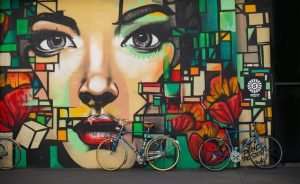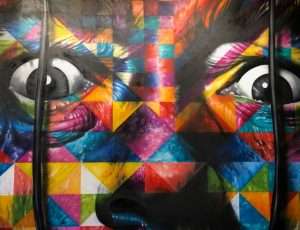I’m interested in the nature of art and how it works. I believe that the medium of an artwork is a vital piece of its meaning. A sculpture is more than the sum of its parts. It’s not just a block of marble, it’s Michelangelo’s David. In painting, pigments on canvas are more than color, they’re Van Gogh’s Starry Night.
~~~
There are two main ways to look at the intersection of medium, content, and meaning. The first is that medium is totally irrelevant. Meaning doesn’t “depend on” or stem from the medium; it simply floats free within the artwork. From this perspective, art is about meaning alone.
The second way to look at medium is that it has a profound impact on meaning. If that’s true, then there are no universal truths about art. Different media will give rise to different types of artistic expression and different ways of seeing the world.
If you believe the latter view, then it makes sense to talk about what kind of “world” an artwork creates for itself. And if you think that the things an artwork is trying to communicate are necessarily linked inextricably with its medium, then you’re going to have a lot of trouble explaining how multiple artists can create similar kinds of art using completely different media.
For example: representational vs abstract painting are very different in terms of technique and effect—one attempts to recreate reality in oil paint and the other attempts to create new realities with lines and color—but they’re often used by artists as a means for communicating similar ideas about humanity and society.*
Both types attempt to describe human experience and
The first time I saw a Jeff Koons balloon dog sculpture, I was confused. Koons is a master craftsman and the work seemed to be made well. But these were clearly mass-produced objects. Shouldn’t I be able to buy one for myself?
No, and here’s why: As art historians will tell you, the meaning of an artwork is affected by its medium. An oil painting, for example, is a flat and lifeless thing. It doesn’t really engage you. A sculpture, on the other hand, has depth and height and a tactile surface. It is more engaging than a painting of the same subject would be.
The balloon dog is an object lesson in this principle: as an artifact it is far less interesting than as an image. The degree of craftsmanship involved makes it aesthetically pleasing; it becomes something you want to own because of its visual appeal and perceived value. But when you see one in the flesh, or rather in the inflated vinyl, you realize that it is just a toy made on an assembly line. You might want one but you don’t really desire it; you don’t need it.
As with most principles of aesthetics, there are exceptions: some pieces of furniture are as visually appealing as jewelry or
The idea that a work of art is about whatever medium it’s in is a very popular one for some “artists” to explore. It’s not, of course, the idea I’d choose to explore, but there are many different kinds of art and many different kinds of artists and so on. I’m just saying: Be wary. The claim that an artwork is really about the medium it’s in is often an attempt to evade responsibility for the meaning or value of what they’ve made.
Art is more than the sum of it’s materials. It’s not just paint on a canvas or clay in a mold. It’s also what it means. Does the artist support an ideology that you think is wrong? Is the art made to disgust you? Or does it make you feel good about being alive?
Art can be used to manipulate people into supporting views they would otherwise reject. The Nazis used art to do this. So did Stalin and Mao and the Ku Klux Klan and many other cults and hate groups. The effect of their art is quite different from the effect of art from sources with similar politics that do not try to make art. The artists aren’t just using their medium to communicate ideas; they are trying to change your thoughts by changing how you feel, by manipulating your emotions, which is a very powerful thing they can do because emotion is not rational.
Something that makes somebody feel better about living may be one way to make them live better. But something that makes them hate other people might also have that effect. How does an artist decide what kind of message is best? And who decides whether the message was delivered? In totalitarian regimes, it’s easy: the government decides both what message is appropriate and if it was effective in getting the desired
The conversations that took place on the jwdartspace.blogspot.com website were intended to be a visual art form of their own, and we believe that the nature of their visual representation should have been taken into consideration when deciding whether or not to shut down the blog.
The blog was very simple in its design, with blog posts represented as rectangular blocks of color, and discussion comments represented as white rectangular blocks with black text. When the colors were muted, as was intended for most of the blog’s history, it felt more like a social network, with blog entries sort of analogous to status updates, and discussion threads attached. When brighter colors were used, it became more like an illustrated journal. These are both classic forms of art-making; so too is blogging (itself an art form).
We are naturally curious about what impact different aspects of this design had on the conversations that took place on the site. Since a “new” version of the site was created at some point, we wonder whether or not this “new” design might have changed how people communicated with one another. We would love to see a detailed analysis of what types of discussions took place on both versions of the site and how they were impacted by their respective designs.[www.jwd
The artist’s hand is often at work during the exhibition process, but it is not the only force at work. The medium itself plays a role in the creation, distribution, and consumption of art. Art has the opportunity to be many things, including a professional investment and an academic pursuit. These roles have unique benefits and detriments.
The artist’s hand is present in the final product; this is part of what makes art art. Yet the hand of the artist alone does not make a good piece of art. It also needs to be seen by others and consumed by them . This is where the medium comes into play.


